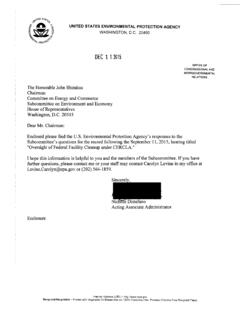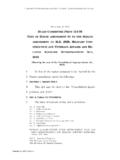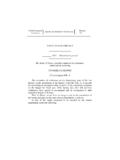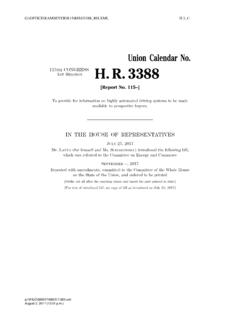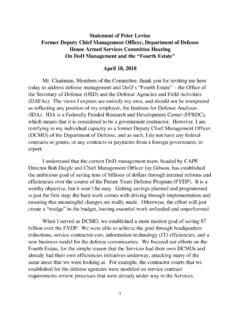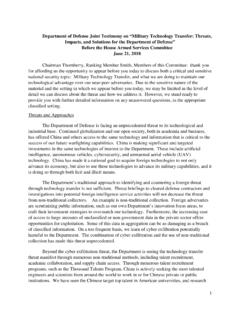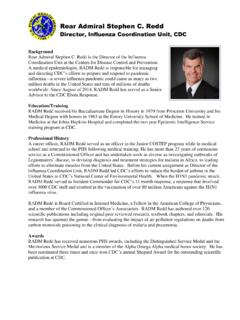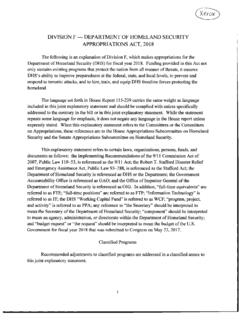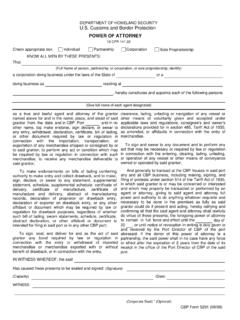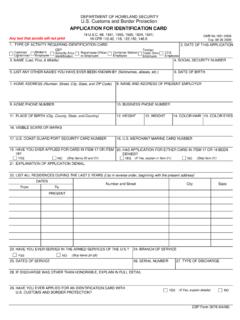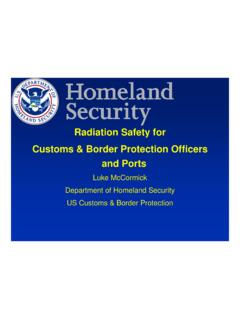Transcription of U.S. Customs and Border Protection - Document …
1 TESTIMONY OF RANDOLPH D. ALLES Assistant Commissioner Air and Marine Operations and RONALD VITIELLO Acting Chief Border Patrol Customs and Border Protection Department of Homeland Security BEFORE House of Representatives Committee on Homeland Security Subcommittee on Border and Maritime Security ON Transparency, Trust and Verification: Measuring Effectiveness and Situational Awareness along the Border March 1, 2016 Washington, DC 1 Chairwoman McSally, Ranking Member Vela, and distinguished Members of the Subcommittee. It is a pleasure to appear before you today on behalf of Customs and Border Protection (CBP) to discuss measuring effectiveness and situational awareness of the Southwest Border . Along the more than 5,000 miles of land Border with Canada and Mexico, and approximately 95,000 miles of shoreline, CBP works with our DHS, interagency, and state and local partners to secure our borders and the associated airspace and maritime approaches to prevent illegal entry of people and goods into the United States, while also facilitating lawful trade and travel.
2 The Border environment in which CBP works is dynamic and requires adaptation to respond to emerging threats and changing conditions. We appreciate the partnership and support we have received from this Subcommittee, whose commitment to the security of the American people has enabled the continued deployment of resources and capabilities we need to secure the Border . The Border Patrol (USBP) and Air and Marine Operations (AMO), in conjunction with DHS Joint Task Force-West, have primary responsibility for the Border security mission between the Nation s ports of entry (POEs) through the coordinated use of integrated assets to detect, interdict, and prevent acts of terrorism and the unlawful movement of people, illegal drugs, and contraband toward or across the borders of the United States.
3 CBP implements intelligence-driven counter network strategies focused on areas of greatest risk, and deploys its capabilities to adapt to emerging threats along the Border . Detecting and interdicting terrorists and their weapons will always be a focused priority. Furthermore, the illegal cross- Border activities of transnational criminal organizations (TCOs) and other bad actors pose a growing threat to Border security and public safety. TCOs control most cross- Border trafficking of guns and illegal drugs, and there is evidence of their increased involvement with human smuggling. Using a risk-informed and intelligence-driven approach, CBP will continue to enhance our efforts to anticipate and respond to threats to our national security, ensure the safety of the public, and deter, prevent, and disrupt future illegal activities.
4 As the preeminent law enforcement agency responsible for safeguarding and managing America s borders, CBP develops and sustains situational awareness of current and potential threats and associated risks. Situational awareness forms the cornerstone of our approach to proactively identify and eliminate criminal and illegal activity across the Nation s air, land, and maritime borders. It is derived from CBP s comprehensive understanding of the threat environment and provides an in-depth picture of the current operating conditions within a specific region of the Border environment. Situational awareness, like the Border environment, is dynamic and grows through a variety of types of information collection obtained through intelligence and surveillance technology and analysis in the context of other regional or national cross- Border trends, especially those concerning illicit trafficking and unlawful Border crossings.
5 CBP leverages a wide range of tactics, techniques, and sophisticated technologies to enhance situational awareness and increase CBP s ability to prevent and disrupt threats in the Border environment. 2 The Border environment in which CBP operates is challenged by continuously evolving tactics of TCOs, terrorists, and other criminals. Detecting changes in threat levels and criminal flows across the Border environment requires the use of various tactics to gather information and intelligence in both low and high threat areas. To promote and advance situational awareness, CBP deploys sophisticated surveillance and detection technology and collaborates with domestic and international law enforcement, intelligence, defense, and local community partners. Advanced Technology and Capabilities Thanks to the support of this Subcommittee, CBP has deployed capable resources to increase our situational awareness, identify changes in the Border environment, and rapidly respond, as appropriate, to areas of increasing risk.
6 The use of technology in the Border environment is an invaluable force multiplier to increase situational awareness. Along Borders The information gleaned from fixed and mobile surveillance systems, ground sensors, imaging systems, and other advanced technologies enhances situational awareness and better enables CBP to detect, identify, classify, monitor, and appropriately respond to threats and other challenges along the borders. The Integrated Fixed Tower (IFT) systems and Remote Video Surveillance Systems (RVSS) are fixed technology assets used in select areas along the Southwest Border . The IFT s ystem is a series of fixed surveillance towers and equipment located in Arizona that provide long-range persistent surveillance. These tower systems automatically detect and track items of interest, and provide centralized operators with video and geospatial location of suspected items of interest for identification and appropriate action.
7 RVSS provide short-, medium-, and long-range persistent surveillance mounted on stand-alone towers or other structures. The RVSS uses cameras, radio, and microwave transmitters to send video to a control room and enable a control room operator to remotely detect, identify, classify, and track targets using a video feed. In some areas along the Southwest Border , CBP also uses Unattended Ground Sensors (UGS) and Imaging Sensors (IS), which contribute to improved situational awareness, agent safety, and rapid response. These sensors support our capability to detect and identify subjects. When a ground sensor is activated, an alarm is communicated to a data decoder that translates the sensor s activation data to a centralized operations center computer system. IS are a specific type of unattended ground sensor with an integrated camera and the ability to transmit images or video back to the operations center.
8 Fixed system technology increases CBP s situational awareness and the Border Patrol s ability to detect, identify, classify, and track illicit activity by providing line-of-sight surveillance to efficiently detect incursions in varying terrain. CBP integrates mobile and portable systems to address areas where rugged terrain and dense ground cover may allow adversaries to penetrate through blind spots or avoid the coverage areas of fixed systems. Working in conjunction with fixed surveillance assets, CBP s mobile technology assets provide flexibility and agility to adapt to changing Border conditions and threats along the Southwest Border . Mobile Surveillance Capability systems provide long-range mobile surveillance with a 3 suite of radar and camera sensors mounted on USBP vehicles.
9 Mobile Video Surveillance Systems provide short- and medium-range mobile surveillance equipment mounted on telescoping masts via camera sensors mounted on USBP vehicles. Another system, the Agent Portable Surveillance System (APSS), does not need to be mounted to a vehicle. These current generation assets provide medium-range mobile surveillance mounted on a tripod and transported by three or more agents. Two agents remain on-site, one to operate the system, which automatically detects and tracks items of interest and provides the agent/operator with data and video of selected items of interest. Next generation APSS options are being explored. These technologies not only provide significant security benefits and multiply the capabilities of law enforcement personnel to detect, identify, and respond to suspicious activity, but they also enhance public safety along the Border .
10 Mobile surveillance technology systems enable agents to position the technology where it is needed at a specific moment, extend our observational capabilities in this case, by helping see through the darkness and increasing the accuracy and speed of our response. CBP s Tactical Aerostats and Re-locatable Towers program, originally part of the Department of Defense (DoD) Reuse program, uses a mix of aerostats, towers, cameras, and radars to provide USBP with increased situational awareness through an advanced surveillance capability over a wide area. This capability has proven to be a vital asset in increasing CBP s ability to detect, identify, classify, and track activity. As of December 2015, USBP agents seized 122 tons of narcotics and conducted over 50,000 apprehensions of illegal Border crossers with the assistance of existing aerostats and towers.
